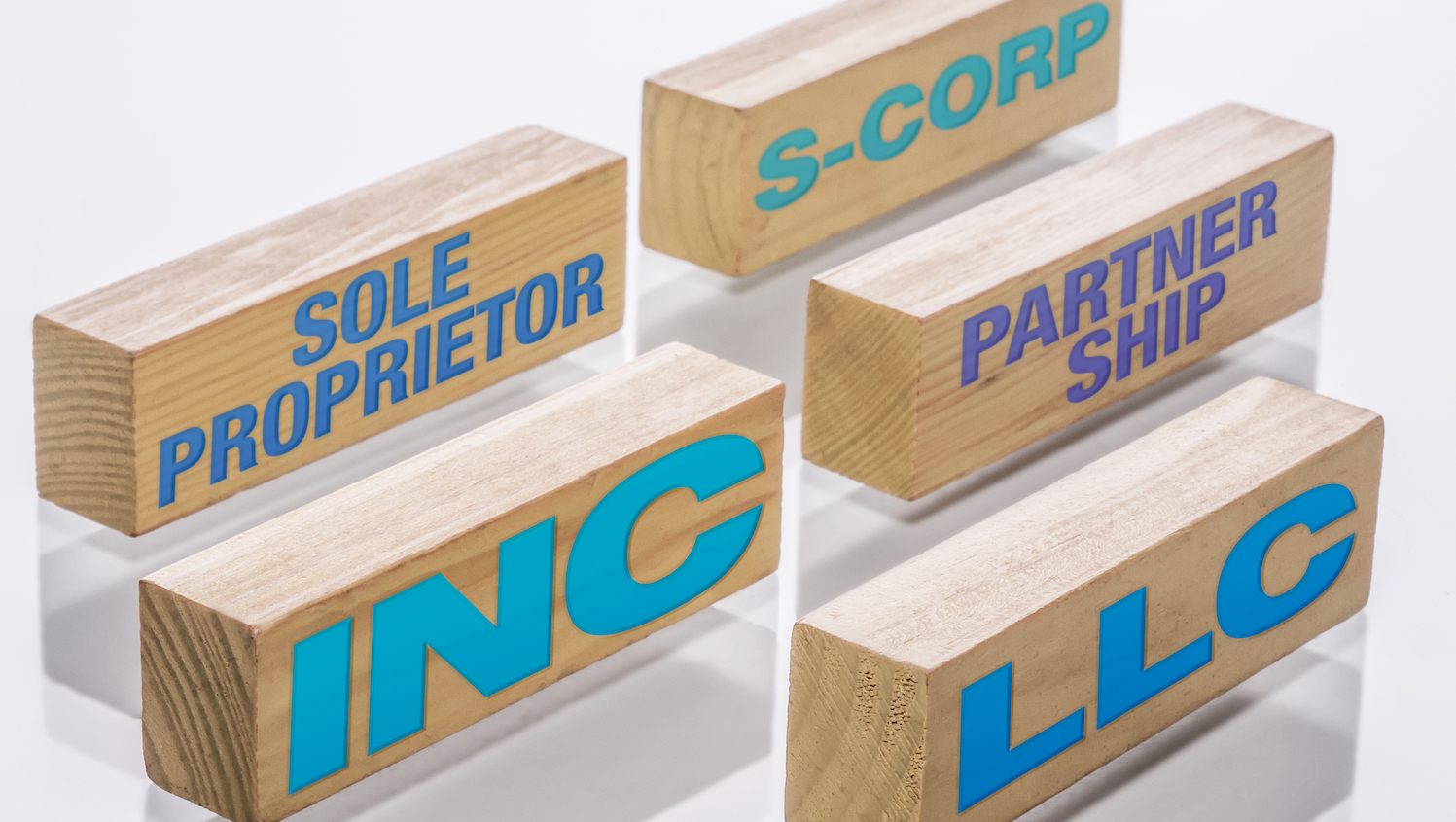The ABCs of LLCs (and C and S Corps, Too)
How you organize your new business has significant legal, tax, and commercial consequences. Two Poole College professors break down different entity types.

By Christina Lewellen and Nathan Goldman
When an entrepreneur begins a new business venture, one of their most important decisions is the type of business entity to organize. That choice affects fundamental aspects of doing business, such as the legal protection afforded to the owners, how business partners will share in the business income, and the tax burdens the business and owners will face.
We recently discussed the implications of entity decisions on an episode of The Hartford’s Small Biz Ahead podcast. Here’s our take on the ins and outs of entities:
What are the differences in legal protection between types of entities?
If an entrepreneur starts a business but doesn’t set up a formal legal business entity, the company will operate as a sole proprietorship by default. In this situation, all the owner’s assets will be subject to unlimited liability of the business. In other words, creditors and attorneys looking to sue the business can come after a business owner’s personal assets.
For example, if a customer or employee decides to bring a lawsuit against the business, they could ultimately come after all the business owner’s assets, including their home or other investments. With more than one business owner, the business could exist as a partnership, similar to a sole proprietorship, but with more than one owner. In a partnership, all general partners face unlimited personal liability, meaning that creditors or lawsuits could target either or both partners’ personal assets.
To avoid this legal liability, business owners might want to consider a form of business that affords liability protection, such as a corporation or limited liability company (LLC). In these business forms, the business has its own legal entity, and the liability is limited to the assets within the business. In this case, a lawsuit might be able to liquidate all the business assets, but the plaintiff cannot come after business owners’ personal assets. If the business has a lot of innate risk, business owners might consider organizing the business across multiple entities, placing other valuable business assets in a separate entity so they are less subject to risk.
In a day and age when lawsuits run rampant, legal protection is a key consideration. Last year, a small business in Oklahoma became the subject of a class action lawsuit regarding the accessibility of the company’s website. Food service companies have also become the targets of litigation based on whether their food products look substantially different than advertisements. Small and large businesses alike can be targets of savvy lawyers and disgruntled employees or customers.
What are the tax differences between entity types?
Corporate and individual tax rates are constantly being debated, and the tax implications of the entity decision have a big impact on a business’s cash flows.
Small businesses generally organize as either a regular C corporation or as a “pass-through” entity. While many might think of a C corporation as a large corporation like Microsoft or Apple, small businesses can also organize as C corporations. The net income of a C corporation is taxed at the federal corporate tax rate, which is currently 21 percent. In addition, dividends paid to the C corporation’s shareholders are taxed on the shareholder’s individual tax returns at dividend tax rates, which range from 0 to 20 percent.
So, if business owners want to take money out of the company, the income gets taxed two times. For example, if a corporation with one business owner earns $100,000, the corporation will pay $21,000 in tax. If the corporation then distributes the remaining $79,000 of cash flow (the $100,000 minus the $21,000 tax paid), the $79,000 will be taxed at the dividends rates of up to 20 percent.
In contrast, a business owner can choose to organize as a pass-through entity that is not taxed independently. There are several types of pass-through entities, including S corporations, partnerships, and limited liability companies (LLCs), among others.
By default, LLCs are taxed as partnerships but an entrepreneur can elect to be taxed as a corporation. The pass-through entity files its own tax return, but the net income the business generates is only taxed on the individual business owner’s tax return at ordinary individual income tax rates.
Using the example above, if the same business is organized as a pass-through entity, the $100,000 would be subject only to individual tax rates ranging from 10 to 37 percent. Then, other business earnings could be distributed to the business owner more freely without facing an additional tax.
The current tax laws also allow a qualified business income (QBI) deduction that lets business owners reduce their individual taxable business income by up to 20 percent.
For example, an LLC member could apply the 20-percent QBI deduction to the pass-through income of $100,000, reducing the income taxed at the individual level to $80,000. The QBI rules are subject to an income phase-out, which means that income over a certain threshold doesn’t qualify for the deduction. The rules regarding the eligible QBI can also be quite complicated, but this deduction can help owners of pass-through entities reduce their individual tax liabilities.
A second tax consideration is employment taxes. Employees face federal employment tax rates of 7.65 percent: 6.2 percent for OASDI (i.e., Social Security) and 1.45 percent for Medicare. Employers match this and pay 7.65 percent of their employees’ wages in these employment taxes. OASDI tax is only levied on wages up to the annual cap—$168,600, as of 2024—but Medicare tax applies to all wages. For some entities, including partnerships, sole proprietorships, and LLCs that are taxed as partnerships, all actively earned income is subject to both the employer and the employee portion of the employment tax. Therefore, owners of these businesses may be subject to an additional tax of up to 15.3 percent on top of taxes on the business income.
For corporations, including S corporations, the business pays the employer part of the employment tax. So, for an S corporation with one shareholder, the business owner would effectively still be responsible for both the employer and employee portions of employment taxes on the salary paid to the shareholder, but they can avoid employment taxes on income after considering the salary. In general, business owners can’t avoid employment taxes by not paying any salary. But they can justify a “reasonable” salary, and then the remaining business income will only be subject to regular individual income taxes.
A third tax consideration that may be especially important for startups is the taxation of losses. With a C corporation, losses will be carried forward and can offset up to 80% of future business income in each subsequent tax year.
For example, if a corporation incurs a loss of $100,000 in the first year and then has $100,000 of income in the second year, the loss in that initial year can reduce taxable year-two income by $80,000—so the corporation will only pay taxes on $20,000 of income. The remaining $20,000 loss carryforward can similarly offset up to 80% of business income in future years until its value is exhausted. Thus, for corporations, the loss does not have an immediate tax benefit, and the tax benefit could be deferred many years into the future to offset large startup losses or several years of losses before the business turns a profit.
In contrast, in a pass-through entity, the loss will pass through to the entity’s owners, so the owners might be able to, in some cases, reduce their tax on other income in the year of the loss.
Can a business owner freely choose between these entity types?
There are some restrictions on entity types. S corporations, for example, can’t have foreign shareholders and are limited to 100 shareholders. Partnerships and other corporations are also barred from holding shares in S corporations.
In contrast, partnerships, LLCs, and C corporations don’t face these restrictions. A corporation that meets the restrictions can elect to be an S corporation, but violating any of these requirements will automatically cause the corporation to revert to a regular C corporation. Once an S corporation reverts to C-corporation status, it can’t become an S corporation again for five years.
Some types of businesses don’t have the C corporation option. For example, accounting firms are not permitted to be C corporations. That’s why you see most large accounting firms organized as limited liability partnerships, which afford some legal protection to the partners.
Are there other, nontax considerations?
One consideration is the types of assets the business owner puts into the business. In general, and especially with small businesses, owners might want to try to avoid putting real estate assets into corporations. Once the corporation owns the asset, it cannot be taken out of the business without a tax consequence.
Should a business owner seek to reclaim a piece of business property as personal real estate or transfer it to a family member, the built-in gain—the difference between the tax basis (cost minus past depreciation) and the property’s fair market value—will be subject to taxes.
For this reason, business owners might want to put real estate in an LLC and the active business in an S corporation or C corporation. Then, the active business can pay rent to the LLC for the use of the building, and the LLC can incur the building maintenance costs. Rental income is not subject to employment taxes, so the payments to the LLC income aren’t subject to employment taxes. Business owners might also consider putting patents or other intangible assets into a separate business entity.
Finally, it’s important to consider the organizational costs. Sole proprietorships, general partnerships and other simpler entity types require very little initial and ongoing costs. However, limited partnerships, LLCs, LLPs and similar organizational forms require careful structuring up front and more stringent reporting of financial activities.
Both S and C corporations must file articles of incorporation, and they may be subject to more nuanced regulatory filings and governance structures (i.e., a board of directors, external auditing). These more intricate systems can contribute substantially to overhead costs.
Entrepreneurs have many tax and nontax factors to consider when starting a new business, and the entity type they choose has significant implications. Business owners also have to think about how tax rates and laws may change in the future, as well as how their businesses will evolve. The taxation of businesses and individuals can also be quite complicated, so we suggest that business owners thoroughly research the laws and generate projections of income in the initial years to fully understand the potential tax differences between different types of entities.
- Categories:


